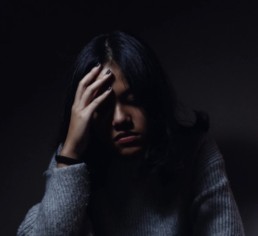
Nearly everyone has experienced headaches at some point. They are often a sign that it is time to eat, rest, and rehydrate. However, the mild pain that results from these sorts of headaches can usually be relieved with a bit of self-care and/or an over-the-counter pain reliever.
Migraines, on the other hand, are an entirely different matter. They bring pain so severe that patients can’t carry on with their normal activities.
When migraines are an occasional affliction, their impact on quality of life is minimal. When they are chronic, they can dramatically disrupt the ability to earn income and manage other responsibilities.
The National Headache Foundation estimates that 40 million people live with migraine disease and headache disorders.
A full four percent of the population has chronic migraines, which is defined as fifteen or more migraine days per month. On those days, patients often find it necessary to spend hours lying quietly in a dark room, which makes it impossible to hold down a job.
All sorts of issues and conditions trigger migraines. Some patients discover holistic reasons for migraines, and others are never able to identify the cause of their suffering.
However, regardless of the reasons that migraines occur, finding effective remedies to prevent and reduce pain is a must if patients are to enjoy a high quality of life.
What Are Migraines?
Those who are fortunate enough to have avoided experiencing migraines often fail to understand the severity of the condition. They don’t realize that migraines are more than a simple headache – they often take over the entire body.
They last more than four hours – and often stretch over days – leaving the patient completely debilitated for a period.
They can start in childhood, but it is also common for migraines to begin in adolescence or early adulthood.
Symptoms of Migraines
Migraines tend to present with four distinct stages, though not everyone goes through each stage every time.
The first stage, prodrome, might bring subtle warning signs that a migraine is coming. These signs might include mood changes, stiffness in the neck, constipation, increased thirst, more frequent urination, food cravings, and persistent yawning.
The second stage is referred to as aura, and it includes signals of disturbance in the nervous system.
For example, patients may experience vision loss, numbness in the face, and weakness on one side of the body. They may see shapes, flashes, or spots of light, feel pins and needles in a limb, or feel uncontrollable muscle spasms.
Some experience difficulty speaking, or they hear noises that others don’t. Scalp tenderness is common, as is a general sense of irritability.
The third stage is the migraine headache itself, followed by the fourth stage: post-drome.
The fourth stage is marked by a relief from pain, but a general sense of exhaustion and confusion that lasts for a day or two.
What Do Migraine Pains Feel Like?
The migraine attack itself has some slight variations from person to person, but generally includes one or more of the following sensations:
- Head pain that pulses or throbs
- Pain that occurs on either or both sides of the head
- Sensitivity to light
- Sensitivity to sound
- Sensitivity to touch
- Sensitivity to smell
- Nausea or vomiting
The symptoms are often so severe that sufferers can only close themselves into a quiet, dark room and wait for the attack to subside.
How Do I Know If I Have A Migraine?
It is important to differentiate between migraines and other types of headaches, because the treatments are markedly different.
Migraines are considered a neurological disease, and within the category, there are a number of sub-types. Cataloguing your symptoms, particularly over multiple episodes, can assist with a proper diagnosis.
These are some of the questions to consider when you experience headache symptoms:
- Would you describe your pain as throbbing, pulsing, and/or intense? If so, you might be experiencing a migraine. Other types of headaches present with a sensation of mild pain and dull pressure.
- Is the pain most prominent on one side of your head? If so, that’s a sign of migraines. Other types of headaches are typically felt across the forehead and into the scalp.
- Are there additional symptoms affecting other parts of your body, including visual and auditory sensitivity or nausea? If so, migraines are more likely, as other types of headaches are typically limited to pain in the head.
Of course, symptoms can vary from person to person, and the answer isn’t always clear-cut. Your physician can assist with a definitive diagnosis, so you can select the most effective treatment plan.
Traditional Treatment for Migraines
The traditional treatment for migraines involves medication – and a combination of medications is sometimes required to bring migraines fully under control.
These may include preventative drugs that patients take daily to keep attacks from coming on. Individual medications aren’t always fully effective, so most patients also require targeted pain relieving medicines that are taken when a migraine occurs.
Migraine Medications
Preventative medications may fall into several categories, depending on the suspected underlying cause of the condition and the symptoms that patients experience.
Typically, this includes drugs designed to lower blood pressure, as well as tricyclic antidepressants and anti-seizure medications.
All carry side effects such as weight gain and sleep disturbances, so doctors work to find a balance between benefits and risks.
There have been new developments in migraine prevention that are showing promise when it comes to keeping the frequency and duration of migraines down.
Some adult patients achieve a certain amount of success with regular botox injections, and others are finding strong results with newer calcitonin gene-related peptide (CGRP) monoclonal antibodies. These are also given by injection.
When a migraine does strike, early treatment is key. At the very beginning, standard over-the-counter pain relievers like aspirin, ibuprofen, and acetaminophen can help.
Some also find relief with migraine-specific OTC medications that combine caffeine, aspirin, and acetaminophen in one pill.
For more serious migraine issues, physicians may recommend one or more of the following:
- Triptans (Imitrex, Tosymra, Maxalt) that block the pathways that send pain signals to the brain
- Dihydroergotamines (Migranal) that are delivered by nasal spray or injection
- Lasmiditan (Reyvow), a new medication that comes in tablet form, offering relief from pain, nausea, and light or sound sensitivity
- Ubrogepant (Ubrelvy), which is an oral calcitonin gene-related peptide receptor antagonist that effectively relieves migraine pain and related symptoms like nausea and light or sound sensitivity
In cases where no other medication is effective, physicians may prescribe opioid drugs. These tend to be a last resort, due to their addictive nature.
Finally, any or all of these may be combined with anti-nausea treatments when necessary.
Holistic Reasons For Migraines
The root causes of migraines appear to vary between patients, and the condition isn’t fully understood at this time.
It appears that genetics play a role in the development of migraines, as do lifestyle factors such as obesity, stress, use of alcohol, and poor sleep habits.
Some researchers are looking at the possibility that changes in the brain stem and how the brain stem interacts with the trigeminal nerve relate to migraines.
There is a clear link between migraines and certain chemicals in the brain, and scientists are carefully studying the role serotonin plays.
For women, there is also evidence that the changes in estrogen levels that occur during the menstrual cycle and with menopause can trigger migraines.
Holistic Treatments For Migraines
Self-care is critical to preventing and relieving headache pain, and many patients attempt holistic treatments for migraines in an effort to avoid heavy-duty drugs and related side effects.
When a migraine appears to be on the horizon, it can be helpful to rest in a dark, quiet room with an ice pack under your neck.
Certain relaxation techniques appear to be effective in reducing stress, which can prevent migraines from coming on. Some patients have experimented with biofeedback and realized great success.
A regular eating and sleeping routine supports full-body health and decreases chemical and hormonal fluctuations. This can reduce the number of migraines patients experience.
Smart nutrition and plenty of fluids build a foundation for better health, as does a routine of gentle exercise. Disciplines that focus on mindfulness, such as tai chi, yoga, and qigong can reduce stress levels and build a stronger mind/body/spirit connection.
Finally, it is wise to consider alternative and complementary wellness therapies such as those offered by practitioners of traditional Chinese medicine. These may include acupuncture or acupressure, targeted massage, and a system of herbal remedies to balance the body’s vital energy, known as chi.
The bottom line is that migraines can be utterly debilitating, and sufferers often find themselves unable to work or fully participate in the activities of daily life. Understanding what triggers migraines and the options available for treatment can reduce the number of headache days and the duration of each attack.
What’s Next?
About the author

